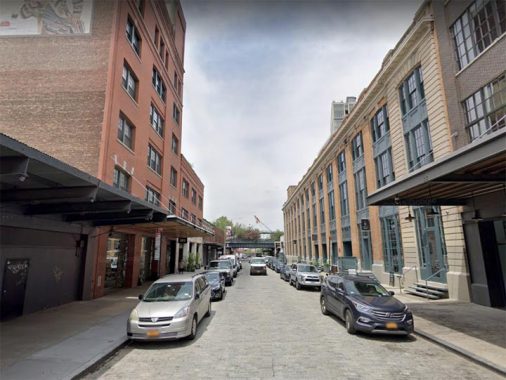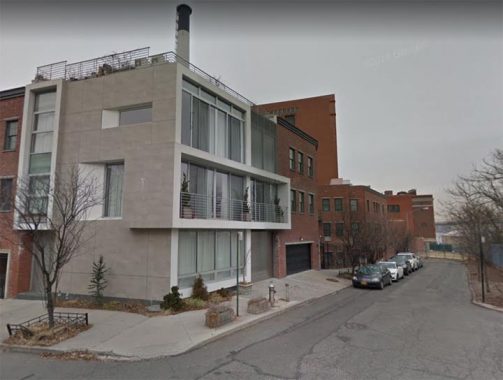I got to thinking the other day (that’s always a dubious proposition; nothing but woe visits when I do that) about the streets in New York City that are “Little.” In most cases that’s just what they are, but there are exceptions to that rule. I thought it would be fun to list NYC’s streets here that have “Little” as a prefix, and note why they have that name—it makes for some interesting research.

Little West 12th Street, Greenwich Village
If you look at a street map of western Manhattan (you can do so here) Little West 12th Street runs between West and Gansevoort Streets, just south of West 13th, occupying territory that West 12th Street would be expected to occupy. But West 12th isn’t here, since there is already a West 12th in the Village, running on the slanted street plan of the neighborhood, a few blocks south of here.
What happened to complicate things?
The answer goes back to the mid-1850s when the city decided to get rid of three Greenwich Village Streets: Amos, Hammond, and Troy, making them western extensions of West 10th, 11th and 12th Streets, respectively. When the Orphan Asylum Society on Asylum Street was torn down in 1833, the city also decided to rename Asylum Street as a northwest extension of West 4th, creating the familiar odd intersections of 4th and 10th, 4th and 11th, etc. that Villagers take in stride these days.
These machinations left that orphaned bit of West 12th between Gansevoort and West Street out in the cold. By 1885, that section was called North 12th, to differentiate it from West 12th, but apparently something a bit stronger was needed and by 1890 or so it was Little West 12th.
Until the 1990s, Little West 12th was the heart of the Meatpacking District, with feverish overnight activity both from wholesale meat distributors and hookers and hustlers alike, but chic restaurants and retail overspread that area beginning in that decade. High rise apartments followed and today, it’s a rather exclusive enclave.

Little Street, Vinegar Hill
Little Street is indeed little…what you see here, one block between Evans and Plymouth Streets with just one address (#60, behind the Brutalist building on the corner) is the entire length of the street. Till a few decades ago there was another block, but the modern Con Ed plant took it over, and you have a better chance of visiting the Sea of Tranquility on the moon than you do getting into Con Ed territory.
However, Little Street is not named for its short length. According to Leonard Benardo and Jennifer Weiss in Brooklyn By Name, it honors a local tavern owner, John Little, who ran a ferry with Captain Samuel Evans (also honored here with a street name) from Little Street across the East River to Walnut Street in Manhattan. (Walnut Street is now called Jackson Street). Unfortunately, this is the best view you can get of the Naval Commandant’s House, which, when the Navy Yard closed in 1966, was sold to a private owner. The mansion was built in 1806. The NY Times’ late great Christopher Gray got inside for a look in 2006.
Little Nassau Street, Clinton Hill
Little Nassau Street runs for one and a half blocks, from Taaffe Place to just past Kent Avenue, just south of Flushing Avenue. Much of its north side is taken up by this massive former stable and administration building for the Department of Sanitation, then the Department of Street Cleaning, constructed in 1904-05 for $370,000. It occupies an entire block and today houses offices for the NYC Department of Environmental Protection.
I’ve never ascertained why it’s called Little Nassau Street. Flushing Avenue is an eastern extension of Nassau Street east of Navy Street; however, at this location, Nassau Street is a couple of miles away and the street should be called “Little Flushing Avenue.” Flushing Avenue south of the Navy Yard has always had that name on maps going back to the 1850s.
Flushing Avenue also doesn’t go to Flushing, Queens, but that’s a long story…
An interesting find on the dead end section eat of Kent Avenue: these lengthy streetlamp masts, supported by a guy wire, used to be quite common around town before the 1960s but were almost always used on telephone poles. This one carries a Westinghouse AK-10 Cuplight, which is missing a reflector bowl and probably a lightbulb.
Little Clove Road, Sunnyside, Staten Island
Little Clove Road is fairly busy, running west and north from Clove Road about a mile to Victory Boulevard on the north side of the Staten Island Expressway in Staten Island’s Sunnyside.
When I first encountered it on bus rides to Staten Island as a kid in the 1960s, I had thought it was created as a service road along with the expressway (yes I thought in those terms even then) but this 1949 Hagstrom proves otherwise.
Little Clove Road isn’t particularly “little” but it’s shorter than Clove Road itself, which “cleaves” a valley in Staten Island, cutting from the north shore all the way to Hylan Boulevard.
Little Neck Boulevard, Bayside
There are three streets called “Little Neck” in Queens, and only one is in Little Neck; I’ll explain presently. In Bayside, Little Neck Boulevard exists in a couple of pieces on 28th Road and 28th Avenue east of 216th Streets so exclusive that the Google Street View trucks aren’t allowed in.
Little Neck Road, Douglaston
Little Neck Road runs one block between Poplar Street and Douglas Road at the LIRR tracks and until recently (12 years ago as of 2020) as 38th Drive. Several numbered streets in Douglaston and Douglaston Hill south of the tracks actually got former or new names with the request of local residents.
Both Little Neck Boulevard and Road are named for Little Neck Bay, the body of water that separates Bayside from the Douglaston peninsula.
Little Neck Parkway, Little Neck
Little Neck Parkway is hardly “little” at all as it is major thoroughfare from just north of the LIRR tracks south to Jericho Turnpike at Floral Park. The parkway, and the neighborhood, are named for the smaller of two peninsulas jutting into Long Island Sound: the larger one is of course Great Neck. In the 19th Century, clams harvested in the Sound were delicacies in NYC restaurants until the waters got too polluted to support them.
Until 1920 or so Little Neck Parkway went by a number of different names; north of Marathon Parkway it was Old House Landing Road, which went to a former dock at Virginia Point. South of that, it was Little Neck Road. When the Queens Topographical Bureau decided to number Queens streets and renumber addresses, the entire length became Little Neck Parkway (instead of the “boulevard” other lengthy roads got).
As an aside there are no “big” streets in NYC; where applicable, the adjective “great” is used as in Great Jones Street in NoHo.
Check out the ForgottenBook, take a look at the gift shop, and as always, “comment…as you see fit.”
7/9/20
